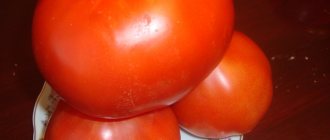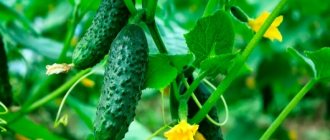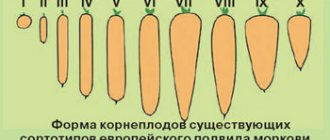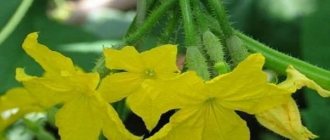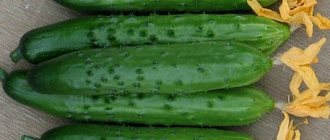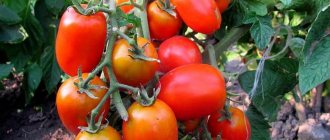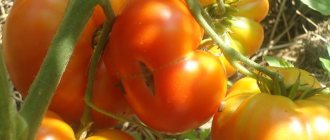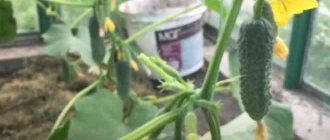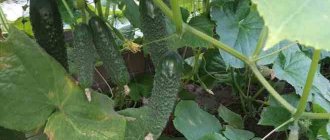Dutch hybrid of international importance
Marinda F1 is a popular variety of early-ripening gherkin cucumber, bred in Holland by Monsanto Holland BV. The hybrid is perfect for growing both under film cover and in open ground. In 1994, it was included in the State Register of Breeding Achievements of the Russian Federation. Since that time, the hybrid has proven itself everywhere in our country. This variety is also very popular abroad.
The plant is very powerful and open, it is easy to care for and collect fruits. Even with unfavorable weather conditions and minimal care, you can get a rich harvest.
Description of the variety and general characteristics
The variety is parthenocarpic and does not require pollination by bees, as it has a predominantly female type of flowering. The fruits are large-tubercular, slightly pubescent, pleasant to the taste: crispy, not bitter, the flesh is dense, juicy.
The ripening period of fruits is 46–55 days, depending on the climatic conditions of growth. In any case, on the 56th day after germination you will definitely taste the first cucumbers! If you provide proper care and nutrition, the plant can form up to 7 fruits per node. The maximum weight of a gherkin is 75 g. The average weight is 65 g. The seed chamber is small. The high yield of the hybrid is especially noted: up to 30 kg per square meter . The gherkins ripen together, forming beautiful, even, dark green fruits. The plants are of medium density, which does not cause difficulties during harvesting.
The variety is perfect for producing gherkins
Hybrids of Dutch selection are very popular. Their characteristics are well suited to the needs of both ordinary gardeners and experienced farmers. Along with Marinda F1, the varieties Masha F1, German F1, Meringue F1, Amur F1 are in special demand.
Under good conditions, the hybrid forms 5–7 cucumbers per node
The fruits are about 10 cm long. For canning, cucumbers are collected a little smaller, without waiting for the maximum size. In any case, no matter what some gardeners write, the cucumber does not outgrow (tested from my own experience). Marinda F1 is an ideal variety for both factory canning and personal farming aimed at selling grown products.
Table: advantages and disadvantages of the Marinda F1 variety
| Advantages | Flaws |
| High yield | Not resistant to downy mildew, anthracnose, angular spot |
| Great taste | Like any hybrid, it loses quality in the second generation of seeds |
| High percentage of seed germination | |
| Does not require pollination | |
| Resistant to fungal and viral diseases: powdery mildew, green mosaic, scab, leaf spot, rot, cladosporiosis | |
| Convenient for harvesting, ripens smoothly | |
| Keeps fresh for a long time | |
| Handles transportation well | |
| Ideal for blanks | |
| Withstands adverse weather conditions well | |
| Early and long-term fruiting | |
| Easy to care for | |
| Universal: suitable for growing both in open and closed ground |
Advantages and disadvantages
Advantages of a hybrid:
- high productivity;
- resistance to adverse climatic conditions;
- immunity to major diseases;
- parthenocarpic type of pollination.
- formation of bundle ovaries;
- attractive presentation;
- excellent taste;
- low price of seed;
- versatility of using ripe cucumbers.
Gardeners love Marinda for the lack of bitterness in the fruits and ease of care. The culture has minimal disadvantages:
- due to lack of moisture, the fruits grow small;
- the hybrid does not like acidic soils with a high nitrogen content.
Planting and care
Marinda F1 can be grown as dry seeds or seedlings.
Seed selection and preparation
Almost every pack of store-bought seeds contains chaff - specimens unsuitable for planting. In high-class seeds this may not be the case. But it’s better to play it safe and sort them by appearance or by immersion in a saline solution. Dilute a little salt in plain water and drop the seeds there. Stir to thoroughly “bath” each seed. The healthy ones, having become heavier, will immediately end up at the bottom of the saucer, while the weak and empty ones will float up. You can safely get rid of the latter. The rest should be quickly dried until flowable. You cannot keep seeds in a saline solution for a long time.
Before planting, the seeds are soaked for a day in ordinary warm water, covered with gauze on top and carefully monitoring the humidity. You can place them in a solution of special fertilizers that help them hatch faster: Rostok, Baikal-EM, etc. This applies to white simple seeds that have not been processed at the manufacturer’s factory.
It is important to remember that extra-class seeds, like Marinda F1, in most cases undergo factory processing for longer storage and better germination. For this reason, soaking such seeds in disinfectant solutions is not recommended.
Nowadays, “colored” seeds are often found on sale. There is no need to process them additionally; everything that is needed has already been done with them by the manufacturers
Oddly enough, cucumbers have the ability to germinate better after long-term storage of planting material. The older the seeds are (two years!), the better they will sprout and produce more female inflorescences.
When all the necessary manipulations with the seeds have been completed, it is time to prepare the soil for planting cucumbers.
Soil for cucumbers
Cucumbers love well-fertilized soil rich in organic matter. Gardeners often add rotted manure to the ground (in a 50/50 ratio. In other sources, 8–10 kg of manure per 1 sq. m). Or they plant it in ready-made black soil. In any case, cucumbers need fertilizer. They do not tolerate alkaline and acidic soils.
Cucumber, like any member of the pumpkin family, feels great on the ground where onions, cabbage, potatoes and green manure (mustard, oats, rye, alfalfa, wheat, phacelia) previously grew. In general, the issue of crop rotation is extremely important. For cucumbers, the best “ally” is corn. Therefore, planting them side by side, in pairs, is very useful. Legumes (peas, beans), dill, lettuce, fennel, garlic, onion, celery, spinach will be good “comrades” for cucumber.
The soil for cucumber crops must be fertilized, soft, and breathable.
Description of the variety
The Marinda F1 cucumber variety is recommended for cultivation in the Central and Central Black Earth regions, where it is adapted to the climate and open ground can be used for its cultivation on an industrial scale.
The hybrid grows well in greenhouses and greenhouses in any region of Russia. Fans of indoor vegetable growing successfully use window sills and balconies to grow the Marinda F1 cucumber variety .
The hybrid has the following characteristics:
Fruit characteristics
How to plant
This question is purely individual for each gardener. Cucumbers can be planted either by seedlings or without seedlings. It all depends on the climate and planting goals. There is a method of sowing three times to obtain an additional harvest at the beginning, middle and end of summer - then you need to choose the seedling method. And if one good harvest per season is enough for you, then use the seedless method.
Seedling method
To get good cucumber seedlings:
- Fill a little more than half the volume of a peat or regular cup with soil, make a small hole and place the seed in it sideways or flat. Try not to place seeds vertically; this position makes germination difficult. Pour warm water (slightly above room temperature).
- Place 1-3 seeds in each hole for security. The depth of embedding is 1 cm.
- Place the cups in a bright and warm place (room temperature should be at least 20 ° C). Cucumbers are very light- and heat-loving, so bright lighting and a comfortable temperature when growing seedlings are required.
- Do not pick, as the root system of cucumbers is very flimsy, it is difficult to tolerate replanting, and sometimes simply cannot withstand it. That is why you need to plant the seedlings immediately in separate cups. If you planted in peat pots, even better! Then you won’t have to remove the cucumbers from them, but simply conveniently place them together with an organic peat cup in the hole and dig them in.
It is most rational to grow seedlings in peat cups
- Do not overgrow seedlings; they do not take root well in a new place, so it is better to plant seeds in mid-May. Of course, different regions have different climatic conditions, and the best thing is to choose the time for sowing the seeds so that the cucumber has two true leaves before transplanting, i.e. at the age of 10–12 days. Believe me, you will have time to get an early harvest!
- Plant grown cucumbers according to a 50 by 30 cm pattern, pour a liter of warm water into each hole.
- Another scheme for planting cucumbers:
This scheme for planting cucumbers is also very effective.
Planting seeds in the ground
For three to four years, cucumbers can grow in “warm beds” without changing location.
Arrangement of a “warm bed”:
- The easiest way: make a high bed (20–30 centimeters from the ground). Its bottom layer can be straw or organic debris, manure, and the top layer can be fertile soil. To start the process of decomposition of organic matter, water the bed generously with warm water and cover it with film. You will know that the bed is ready (“on fire”) when it begins to steam slightly when loosened, and the temperature of the soil is like a medium-heated oven. In such an environment, the roots of small cucumbers will feel very comfortable.
In the lower tier of the “warm bed” we place straw, which, when decomposed, will warm the cucumber roots
.
- Then you need to remove the film, make holes 15–20 cm wide, at a distance of 50–55 cm from each other. Place 2–3 seeds per hole to a depth of 2–2.5 cm.
- It is better to mulch such a ridge with a small layer of peat. But this must be done if the cucumbers are planted in open ground. I don’t recommend mulching in greenhouses to prevent the roots and root area of the stem from rotting. However, if it is very hot there, the soil dries out quickly; it is still better to cover the ridge on top with a small layer of sawdust or peat.
- In an open area or in a greenhouse without shelter, be sure to build a trellis (a support for forming and strengthening the stem). You can make a simple one from meter slats. As the plants grow, tie the vines to the trellis, which will provide convenience during care and harvesting. Additionally, in this way, a uniform distribution of sunlight and heat throughout the ridge will be created. The plant will not “sour”, sticking to the ground, and the fruits will not end up on the soil.
Video: preparing a “warm bed” and sowing seeds
Photo gallery: options for trellis supports
Various trellis designs for cucumbers
The support ensures correct and comfortable growth of the climbing plant
A support for cucumbers made from twine is very convenient and less labor-intensive than a slatted one. However, the garter twine will need to be renewed every year.
Optimal growing conditions
To obtain a good harvest, Marinda F1 cucumbers are planted on light, fertile soil with a low nitrogen content. The beds are located in a sunny area, well protected from drafts. To increase productivity, you can add sawdust or rotted compost to the soil when digging.
The best temperature for growth and development is 22-26 degrees. At temperatures below 14 and above 40 degrees, the Marinda cucumber stops growing and sheds its ovaries, which significantly affects the yield.
Care after landing
If you grow cucumbers in open ground, it is better to cover them with a special non-woven material at night. And if your cucumbers are in a greenhouse, know: a heat threshold of 30 ° C is a sure sign to shade the roof with the same covering material.
It is recommended to loosen cucumbers infrequently (once a week is enough). The roots of cucumbers are located shallowly in the soil; they seem to creep without going into the depths of the ridge. Therefore, you need to loosen it very carefully. It is better to make small grooves between the holes and between the rows.
Be careful not to expose the root stem of the cucumber. Otherwise, you won’t get a rich harvest: the plant will begin to get sick and die quickly. The best method of prevention is regular hilling of the stem. If you still overlooked it, you can smear the stem with lime and sprinkle with onion infusion.
It is believed that dill prolongs the fruiting of cucumbers. Garlic protects them from bacteriosis. Root secretions from lettuce and spinach stimulate the development of cucumber roots and perfectly protect the soil from overheating. Legumes store nitrogen, so don't dig up their roots after harvest, just cut off the top of the plant. Radish will protect cucumbers from spider mites. And corn perfectly protects plantings from the winds.
Many summer residents advise pinching the top of the cucumber stem so that side shoots form more intensively. This will make it possible to multiply the harvest by almost one and a half times, because a larger number of inflorescences are formed on the shoots than along the entire length of the main stem.
Watering and fertilizing
Remember that heat-loving cucumbers should never be watered with cold water! This will slow down their growth and worsen the condition. Cool water can cause the ovaries to die. It is best to water in the morning, before the scorching sun, or in the evening.
Before flowering, cucumbers can be watered once every 7–10 days, approximately 3–4 liters per square meter. m. But during the growth of color and fruit setting, watering should be carried out more often: every day or every other day (as the soil dries) 7-10 liters per square meter. m. And the forty-degree heat will require even more frequent watering (under such conditions, even 2 times a day will not be superfluous). All figures are purely advisory; be guided by the climate of your area and weather conditions (air temperature, rain, fog, wind, abnormal phenomena, cyclones).
Gardeners often complain about the bitterness of fruits. The reason for this is insufficient watering. As soon as you give the cucumber more water, the fruits will become juicy and tasty. Do not forget that this crop consists mostly of water, and therefore during ripening it is in dire need of sufficient watering.
Video: how to properly water cucumbers, says gardening fairy Oktyabrina Ganichkina
As soon as cucumbers begin their intensive growth, their nutritional needs will increase. It's time to add fertilizers to their cultivation. It is important to know what and when to “give” to this culture. Don’t overdo it with chemistry, it’s better to use simple, proven methods.
Table: timing of fertilization for cucumbers
| Period | Type and dose of fertilizer |
| Beginning of flowering | 2 cups of ash + 10 gr. urea or 1 teaspoon of urea, 1 teaspoon of superphosphate, 1 glass of mullein per 10 liters of water |
| Every 2 weeks after flowering | Half a liter of mullein per 10 liters of water + 1 teaspoon of potassium sulfate |
| Fruiting - fertilizing every 10 days | A glass of ash per 10 liters of water |
In general, their appearance speaks eloquently about the condition of cucumbers. If the leaves of the plant are weak and dull, there is not enough nitrogen. If the ovaries rot and fall off, and a white border appears on the leaves, there is a potassium deficiency. Boron and phosphorus affect the shape and development of the fetus. If there are not enough of them, the flowers become small, the fruits are ugly, and the leaves take on a grayish tint.
Expert opinion: according to my observations, burying nettles in the soil where cucumbers will grow is one of the best methods to enrich the soil with microelements. In addition, nettle is an antiseptic for the earth. I know firsthand that nettle infusion is the best fertilizer. Thanks to its rich composition (silicon, iron, nitrogen, potassium, sulfur, calcium, amino acids, etc.), watering with this infusion will definitely have a beneficial effect on cucumber seedlings.
Video: how to tie cucumbers, how to feed them, how to water them
Agricultural technology for growing in open ground and greenhouses
Miranda is quite thermophilic, so cucumbers are planted in the ground in June, at the beginning of the month, under cover in mid-May, and in greenhouses in April-May. The most comfortable temperature for growth is considered to be 24–28 degrees during the day and 18–22 degrees at night. 15 degrees above zero slows down the growth of cucumbers, and 8–9 degrees can kill them.
Marinda bears fruit a couple of months after the first seedlings appear.
The yield of the variety is up to 30 kg per 1 sq.m.
When growing in open soil, you should remember the need:
- Healthy and fertile soil for growing.
- Before planting, add humus/compost and ash to the soil.
- The place should be sunny and windless.
- Sow either sprouted or dry seeds, adding three to a hole; during germination, the excess is removed.
- Water with warm, settled water.
- It is important to water every day, keeping the soil moist.
- It is advisable to cover the soil under the plants with mulch to prevent the formation of fungi.
- Don’t forget about feeding; stopping feeding and watering can be perceived by the plant as stopping growth and vegetation.
Rules for introducing fertilizing:
- Before the flowers appear, during the active growth phase, it is advisable to feed with mullein infusion, bird droppings or herbal infusion.
- When flowering, a herbal infusion is perfect.
- When the fruit appears - herbal infusion (10 l) and ash (glass).
- Fertilizer is introduced after watering the plants.
- The frequency of administration is once every ten days.
Organic fertilizer was discussed above, and mineral/purchased fertilizer (ammophos, potassium and ammonium nitrate, superphosphate, urea) is also used, often alternately with organic fertilizer, however, it can be excluded from use.
Diseases and pests
Cucumbers need to be constantly inspected - there are too many diseases in this crop. And the main thing here is to notice and correct the matter in time.
Table: diseases characteristic of the Marinda F1 variety, methods of combating them
| Disease | Signs of defeat | Fighting methods |
| Downy mildew or downy mildew | Formation of spots on leaves, yellowing of leaves, shoots, rotting of ovaries. The plant dies within 1–2 weeks | Maintaining crop rotation, seed treatment, maintaining optimal soil moisture, ventilating the greenhouse, treating with fungicides (for example, copper oxychloride).
|
| Anthracnose | A depressed brown spot appears on the seedlings in the area of the root collar. Soon the infection spreads throughout the stem in the form of yellow spots. The plant dies within a week | Maintaining crop rotation, seed treatment, maintaining optimal soil moisture, ventilating the greenhouse, treating with fungicides (for example, copper sulfate).
|
| Angular spot | Light brown weeping spots appear along the edges of the leaf, then most of the surface becomes covered with necrosis. The plant dies within 2–3 weeks | Compliance with crop rotation, treatment with copper-containing preparations.
|
Photo gallery: typical signs of variety diseases
downy mildew destroys cucumber leaves
Typical external signs of anthracnose, which destroys many plants
These are the external signs of angular spot disease
Getting rid of parasites
Fighting cucumber diseases is half the battle. Do not forget that this crop has many pests. It is important to protect cucumbers from harm in time or, if this has already happened, to properly get rid of harmful living creatures.
Table: cucumber pests, control measures
| Pest | Signs of defeat | Fighting methods |
| Slugs | Gnawed leaves and shoots, slugs can cause irreparable damage to the plant and fruits. Active at night or in cloudy weather |
|
| Greenhouse whitefly | The pest lays eggs on the underside of the leaf. The larvae (0.3 mm) hatching from the eggs stick to the leaf and become like light green flat scales. The larvae feed on plant juices. Usually on one plant the pest is in different stages of development, which greatly complicates the fight against it. In addition, the greenhouse whitefly is the causative agent of cucumber mosaic. Signs of damage: general depression of the entire plant, white spots on the leaves, their yellowing and death, a sharp decline in yield |
|
| Aphid | Small insects. They produce sticky excrement that promotes the proliferation of soot fungus and phytopathogenic viruses. Aphids can attack stems, leaves and flowers. Mass reproduction of the pest leads to the death of the plant |
|
| Spider mite | The leaves, whose sap the mite feeds on, become marbled in color, turn brown and dry out. Ticks multiply massively in dry, hot weather |
|
Photo gallery: the main pests of the hybrid
Slugs can damage both the plant itself and its fruits.
The most common type of pest is aphids
A seemingly microscopic spider mite can cause considerable damage.
Description
This variety is parthenocarpic, that is, setting and filling of fruits occurs without the participation of pollinating insects.
Parthenocarpy in cucumbers is a natural property, fixed through long-term selection at the level of a stable trait, and is not related to genetic modifications (GMOs). Since seeds do not ripen in unfertilized fruits, products at the stage of consumer ripeness have high marketability:
The harvest is formed on the 40-55th day after emergence; many vegetable growers note its stability and duration throughout the entire growing season of the plant.
The plant is unlimited in growth (indeterminate), but at the same time quite open and not dense - medium-sized, moderately climbing, with small leaves. It is recommended to grow it both vertically (on a trellis or mesh) and horizontally (without supporting structures). The cucumber hybrid “Marinda F1” is unpretentious in care, well adapted to adverse weather conditions, has high stress resistance and environmental plasticity, and is not susceptible to common viral and fungal diseases: cucumber mosaic, olive spot and powdery mildew.
“Marinda F1” has gained particular popularity due to the versatility and excellent taste of greens. The hybrid is one of the most popular short-fruited varieties of cucumbers, intended for all methods of canning and fresh consumption. Green gherkins (8-10 cm long, about 3 cm in diameter, weighing on average 65-70 g) have a cylindrical shape and a dark green color with short light stripes. The peel is covered with large tubercles with white pubescence. The pulp is juicy and crispy, dense, uniform consistency, with small seed chambers. Zelentsy have a distinct fresh aroma and a pleasant sweetish taste, completely devoid of bitterness.
If harvested untimely, cucumber greens “Marinda F1” tend to grow thick, which makes them look barrel-shaped.
Since when growing hybrid cucumbers, only purchased seed material is used, germination, survival rate of seedlings, and compliance with the declared varietal characteristics depend on its quality. Many foreign and domestic companies are engaged in the production and sale of seeds of the Marinda F1 hybrid.
Often the packages indicate that the seeds are coated or encrusted. Externally, they are distinguished by their bright turquoise or pink color with a pearlescent tint.
You can find out what cucumber seeds “Marinda F1” from agro look like and what you should pay attention to when purchasing them from the following video:
With regard to seeds covered with protective and nutritious shells, it is important to understand that before planting they cannot be subjected to pre-treatment: soaking, disinfection or hardening. The shell contains micro- and macroelements that stimulate growth and provide protection for young plants from diseases and pests. After sowing such seeds, it is important to water the soil abundantly so that the shell dissolves and does not interfere with germination.
Breeding work to improve the consumer properties of well-proven cucumber hybrids is ongoing. As a continuation of the “Marinda F1” line, Dutch specialists from Seminis have created:
| Name | Year of inclusion in the State Register of Russia |
| "Madita F1" | 2008 |
| "Maresa F1" | 2011 |
| "Masha F1" | 2000 |
| "Meringue F1" | 2007 |
| "Monisia F1" | 2011 |
Despite the emergence of a huge number of new products, the hybrid cucumber “Marinda F1” still enjoys well-deserved trust and high demand among Russian vegetable growers.
Harvest and storage
Cucumbers should be harvested as they ripen. The Marinda F1 variety has several such periods: 55 days after germination, then every two to three days. The culture tends to rest for a short time, then reap the fruits. Until the end of August and even mid-September, you will successfully collect gherkins. By the way, they ripen very quickly, and therefore there is no need to bypass the garden bed for a long time after the first harvest.
There are several rules for collecting cucumbers:
- no need to pick the fruits with your hands. The stems of cucumbers are weak and sensitive, the lashes are tender and vulnerable. The plant is easy to damage, which will naturally affect its development and further harvest. So use pruning shears or regular scissors;
- It is better not to disturb adult lashes; turn them over too much. Shifting them from place to place changes the natural direction of growth of the formed plant, the angle of sunlight, the supply of nutrients and water. All this will negatively affect productivity;
- remove unformed, ugly fruits (in the Marinda F1 variety they are rare, but there are still sad exceptions, mainly due to climatic anomalies or agrotechnical errors).
Marinda F1 is one of the most productive varieties. But be careful not to damage the plant when harvesting
There are a huge number of ways to preserve cucumbers. But fresh storage raises more questions than answers. There is one tricky way: cut a ripe, tight head of winter cabbage in a cross shape and place the gherkin as deep as possible into the cut so that the leaves tightly cover the fruit. This way you can keep the cucumber fresh until winter, while the cabbage is stored in the cellar.
Reaping the fruits is the favorite time for the gardener
It is very difficult to store cucumbers collected from the garden. A good crop grown without chemicals will last a maximum of 4-6 days, and then begin to wither or rot, due to the fact that the fruits have a high liquid content - almost 97%. If you need to store cucumbers for several days, then place them in boxes and place them in a cool place or place them in a plastic bag, seal them tightly and store them in the refrigerator. The lower the temperature, the longer the greens are stored. To preserve freshness longer, it is recommended to grease the fruits with egg white and wrap them in paper.
At a temperature of +1–0 °C and a relative humidity of 85–90%, cucumbers wrapped in paper and placed in boxes can last up to 20 days without losing their nutritional and taste qualities.
Lightly salted cucumbers for the winter
Rinse the gherkins and place them in a bowl of cold water for 5–6 hours. During this time, change the water 2-3 times.
Place washed dill, horseradish leaves, currants, and cherries at the bottom of a sterilized jar. Throw a couple of fragrant clove inflorescences and a pod of hot red pepper into the jar. Prepare the brine: 50 g of salt per 1 liter of water. Boil, cool.
Place the gherkins tightly in a jar with herbs and seasonings, pour in brine, and again add dill inflorescences and horseradish leaves on top. Do not close the jar, but tie it with clean gauze and keep it in a room with a temperature of up to 20 °C for 5 days. Then try: if the taste is pleasantly sour, you can drain the brine. Rinse the cucumbers in clean water and put them back into the jar with herbs and seasonings. Boil the brine, remove the foam and pour it hot into a container with cucumbers. Do not fill the jar completely; leave 1.5 cm to the top of the neck.
Seal the workpiece hermetically and sterilize it in hot water for 10 minutes. The brine will be cloudy for some time, but will then become transparent. These cucumbers are extremely tasty: crispy and aromatic.
The result of the garden summer
Further care for the Marinda cucumber variety
Caring for planted cucumbers includes, first of all, compliance with the irrigation regime:
- Before buds appear on the vines and in hot weather, cucumbers are watered daily. Up to 1 liter of water is added for each plant, and up to 5 liters of water for each square of area;
- During the formation of ovaries and during the collection of ripe fruits, the amount of watering is reduced, but the volume of moisture added is increased. 2-3 times a week, about 1 bucket of water is added to the cucumber beds for each square of area;
- from the second ten days of August, the volume and frequency of watering is reduced - no more than 700 ml of water is applied to each plant once every 6-8 days.
FORMATION OF PARTHENOCARPIC CUCUMBERS - video
Water for watering cucumbers should be settled and warm. Cold water can trigger the development of root rot in this vegetable crop.
In greenhouse conditions, it is better to tie cucumbers of this variety to trellises.
Reviews from gardeners about the cucumber variety Marinda F1
I planted Marinda F1 cucumber seeds from Agromarket seedlings. Each seed in a separate glass. Out of 10 seeds, 10 sprouted. I planted seedlings in open ground that had six leaves and took root well. She grew quickly. The cucumbers bloomed very well, there was a germ on every flower, there were no bees anywhere near, and every cucumber started to grow. I collected cucumbers every day. I fed it only twice over the summer. The cucumbers are strong, crispy and tasty. They are good everywhere: in pickling, in rolling, and in salads.
tatyana2011, Russia, St. Petersburg
https://otzovik.com/review_1310612.html
Among the huge number of cucumber varieties and hybrids, there is one that I fell in love with at first sight and for the rest of my life. We are talking about the magnificent Dutch Marinda F1.
As soon as I first planted this beauty in my greenhouse, and this happened about 12 years ago, I never parted with it. And I must say that in all these years my favorite has never let me down. Its main advantages include high productivity. Even in the unfavorable conditions of last summer, I picked several buckets of strong, flattened, crispy gherkins from a dozen bushes that look great in jars. The taste of the Marinda cucumber is excellent both fresh and pickled.
nechaevatu, Russia, Perm region
https://otzovik.com/review_3030703.html
There have always been problems with cucumbers: sometimes they get sick, sometimes there’s a bad harvest, or something else. A few years ago they recommended Marinda, and now we don’t have any problems. We poured water over the seeds, planted them in open ground a couple of days later - and that’s it. Literally after 3-4 days they begin to germinate. There are 10 seeds in the package, and 9 germinate accurately. Another plus: they are self-pollinating and resistant to diseases; during the whole summer they were treated once with special chemicals - and that’s all. I am very pleased. Cucumbers grow very quickly, if you water them well in the evening, then in the morning you will have excellent gherkins. If you like it bigger, then you need to wait until the evening. With 10 bushes, we roll cucumbers every 4 days, not counting what else we eat. Even this year they decided to conduct an experiment: they planted them in mid-August, they have already sprouted, and we are waiting for the harvest.
nikyli4ka, Ukraine
https://otzovik.com/review_1295265.html
From all that has been said above, we can conclude that the Marinda F1 variety is a successful hybrid, deservedly having high scores in many indicators, which give it the right to permanent registration in every garden.
- Author: Natalya Varnavskaya
26 years old, blogger, farmer, young mother, illustrator, graphic designer, freelance correspondent. Higher education in the humanities. I live in Siberia, Ulan-Ude, Republic of Buryatia. Extensive experience in growing garden crops. Rate this article:
- 5
- 4
- 3
- 2
- 1
(0 votes, average: 0 out of 5)
Share with your friends!
Reviews
Vitaly, 44 years old, Pskov region.
We have been planting the Marinda F1 cucumber in the greenhouse for many years. In terms of productivity, few can compare with it, even among the new and improved hybrids. It requires minimal care and bears fruit well, despite weather disasters. This summer turned out to be cold - cucumbers were a little late, but in principle they are early ripening and usually ripen in 40-42 days. Strong, smooth gherkins with excellent taste. Very juicy, crispy, sweet. In our family, it’s customary to pickle cucumbers, and Marinda is perfect for this. No matter how many cans we close, we eat them all over the winter!
Natalya, 51 years old, Poltava
Of the “old” Dutch cucumbers, this is the variety that has taken root best in our country. We buy Seminis seeds in small packages of 10 pieces per bag. Although they are expensive, the germination rate is almost 100% and they hatch quickly. We don’t bother with seedlings; we sow them straight into prepared beds and cover them with film at first. For cucumbers, we make a trellis from stretched ropes, and mulch the soil with mowed grass. We tried to form the bushes into one stem, but even without pinching they remain quite open. There are a lot of cucumbers placed on the vines at once, a bouquet in each bosom, and they begin to fill up together. Therefore, be sure to feed them with ash and manure, and in hot weather, water them every day with plenty of water. The harvest is huge, I collect it all the time and immediately preserve it. In brine and marinade, the taste of cucumbers is excellent, no voids are formed, everything remains strong and crispy.
Ksenia, 35 years old, Moscow region.
We can say that cucumbers feed us! We are engaged in the “cucumber industry” and grow mainly professional parthenocarpic hybrids – Dutch high-yielding ones. Previously it was Herman, Libelle, Marinda. But all hybrid forms that have existed for over 10 years are becoming obsolete and no longer meet market requirements. Today we order Director, Meringue and Kibria cucumber seeds directly from Holland. They are obtained by crossing the Herman and Marinda lines and combine their best qualities. Almost all of the products from them are marketable, the main part goes for sale, but you also have to salt and marinate yourself.
Tamara, 60 years old, Kaluga
I really liked this cucumber. No matter how many years I have been planting, it has never let me down. Even in the last lean year, my 10 bushes produced several buckets. The cucumbers are all small and even, sweet and crispy, proven and reliable in canning. Look great in jars. The variety pleases with its unpretentiousness and disease resistance. We carry out preventive treatments with Previkur, blind the central stem to 4 leaves and add stepsons here and there. We make sure that the leaves do not come into contact with the soil and that the bush is well ventilated. Since Marinda is self-pollinating, it consistently bears fruit in a greenhouse without insects. Cucumbers are tied in bunches and poured at a time, 10-20 pieces on each bush. Remarkably productive and amazingly tasty cucumber.
Danil, 38 years old, Gubkin
My parents grew Marinda F1 cucumbers on the balcony. I didn’t even believe it when I saw powerful green bushes with a lot of ripening cucumbers. In addition, they turned out to be very tasty and juicy. They smelled and crunched much better than store-bought ones. Every other day we harvested and ate fresh cucumbers with pleasure, and my mother also managed to close several jars of pickled ones. So now we always have our own vegetables from our home garden on the table.
